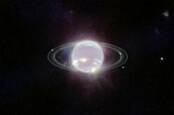James Webb spots water vapor in rocky planet-forming disk
Turns out proto-Earths may bring their own drinks
Astronomers have detected water vapor in the inner region of a protoplanetary disk – where rocky planets may be forming – for the first time, thanks to the James Webb Space Telescope.
Located 370 light years away, PDS 70, a K-type star, is surrounded by a giant hot swirling jumble of gas. This protoplanetary disk is separated into two parts by a gap five billion miles (eight billion kilometers) wide – a telltale sign that material is coalescing to create new worlds. Scientists believe two gas giants are forming in that gap. They also say they have spotted water vapor in the disk's inner area before the gap, where rocky terrestrial planets may be being born.

Epic: Artist's impression of the PDS 70 star; its inner protoplanetary disk where rocky worlds may be forming; a large gap in which two or more gas planets may be coming together; and the outer protoplanetary disk ... Credit: NASA, ESA, CSA, J. Olmsted (STScI)
"We've seen water in other disks, but not so close in and in a system where planets are currently assembling. We couldn't make this type of measurement before Webb," said Giulia Perotti, a postdoc fellow at the Max Planck Institute for Astronomy in Germany and lead author of research into PDS 70 and its planet-forming disk, published in Nature on Monday.
It's the first time scientists have managed to detect water vapor in the terrestrial zone of a protoplanetary disk. The findings suggest that if rocky planets are forming around PDS 70, they could have direct access to water, giving astronomers a glimpse into how Earth may have formed.
Earth is a ball of rock covered in oceans, as we're sure you all know, though it's not clear how it got its water. Last month, a separate team at the University of Copenhagen's Centre for Star and Planet Formation found that planets like Earth may have got their water during their formation process. As Earth grew, icy particles from its surrounding protoplanetary disk were sucked in as it accumulated mass and size.
- Existential dread time: One day Earth's oceans will boil. This exoplanet might reveal when
- Water-hunting NASA cubesat won't reach Moon after total thruster fail
- The balmy equator of Mars looks rich in opal-bound water
If that's right, these particles would be the source of water on our planet – they were already there in space around our small world from the start. It's possible that the same thing is happening now to rocky planets forming around PDS 70, which contradicts theories that Earth's water came from far away and was delivered by, say, comets.
"Our findings show water in the inner disk of PDS 70. This implies that potential terrestrial planets forming therein have access to a water reservoir," the paper by Perotti et al concluded. The discovery was made after MIRI (the Mid-Infrared Instrument) on the James Webb Space Telescope sniffed water vapor within PDS 70's inner protoplanetary disk at distances less than 99 million miles (160 million kilometers) from the star.
The next step is trying to figure out the source of the water vapor and what form it is in. The academics believe water molecules could be coalescing directly from atoms combining in the disk or that icy grains from the colder outer edge moved past the gap and made their way toward the hot inner region, where they sublimated to form a gas.
"We find a relatively high amount of small dust grains. Combined with our detection of water vapor, the inner disk is a very exciting place," said the aptly named Rens Waters, co-author of this month's study, and an astrophysics professor at Radboud University in the Netherlands.
The academics also want to understand how water vapor can survive at distances so close to the star when its ultraviolet radiation should break the molecules apart. One possibility is that they are shrouded in a cloud of dust, and boffins will study the system in more detail with Webb's NIRCam (Near-Infrared Camera) and NIRSpec (Near-Infrared Spectrograph) instruments. ®

 Biting the hand that feeds IT
Biting the hand that feeds IT